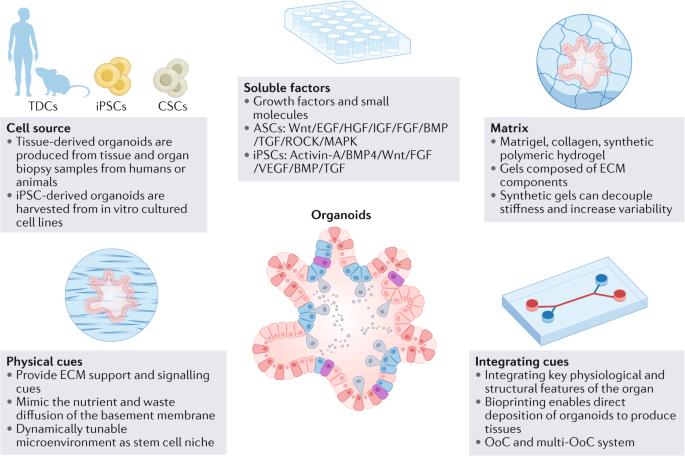Organoids
IF 56
Q1 MULTIDISCIPLINARY SCIENCES
引用次数: 52
Abstract
Organoids are simple tissue-engineered cell-based in vitro models that recapitulate many aspects of the complex structure and function of the corresponding in vivo tissue. They can be dissected and interrogated for fundamental mechanistic studies on development, regeneration and repair in human tissues, and can also be used in diagnostics, disease modelling, drug discovery and personalized medicine. Organoids are derived from either pluripotent or tissue-resident stem (embryonic or adult) or progenitor or differentiated cells from healthy or diseased tissues, such as tumours. To date, numerous organoid engineering strategies that support organoid culture and growth, proliferation, differentiation and maturation have been reported. This Primer highlights the rationale underlying the selection and development of these materials and methods to control the cellular/tissue niche; and therefore, the structure and function of the engineered organoid. We also discuss key considerations for generating robust organoids, such as those related to cell isolation and seeding, matrix and soluble factor selection, physical cues and integration. The general standards for data quality, reproducibility and deposition within the organoid community are also outlined. Lastly, we conclude by elaborating on the limitations of organoids in different applications, and the key priorities in organoid engineering for the coming years. Organoids are cell-based in vitro models derived from stem cells, reconstituting the complex structure and function of the corresponding tissue. In this Primer, Zhao, Chen, Dowbaj, Sljukic, Bratlie, Lin et al. discuss the development of organoids and methods for controlling their cellular environment.

类有机物。
有机体是一种基于细胞的简单组织工程体外模型,能在许多方面再现相应体内组织的复杂结构和功能。可以对它们进行解剖和检测,以对人体组织的发育、再生和修复进行基础机理研究,还可用于诊断、疾病建模、药物发现和个性化医疗。类器官来源于多能或组织驻留干细胞(胚胎或成人),或来自健康或患病组织(如肿瘤)的祖细胞或分化细胞。迄今为止,已有许多支持类器官培养、生长、增殖、分化和成熟的类器官工程策略被报道。本手册重点介绍了选择和开发这些材料和方法的基本原理,这些材料和方法可控制细胞/组织龛,从而控制工程类器官的结构和功能。我们还讨论了生成强健类器官的关键注意事项,如细胞分离和播种、基质和可溶性因子选择、物理线索和整合等。此外,我们还概述了类器官社区内数据质量、可重复性和沉积的一般标准。最后,我们阐述了类器官在不同应用中的局限性,以及未来几年类器官工程的重点。类器官是以细胞为基础的体外模型,源自干细胞,能重建相应组织的复杂结构和功能。在这本《入门》中,Zhao、Chen、Dowbaj、Sljukic、Bratlie、Lin 等人讨论了类器官的发展及其细胞环境的控制方法。
本文章由计算机程序翻译,如有差异,请以英文原文为准。
求助全文
约1分钟内获得全文
求助全文

 求助内容:
求助内容: 应助结果提醒方式:
应助结果提醒方式:


